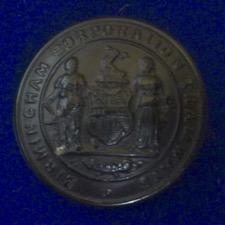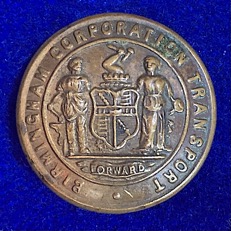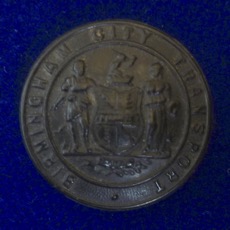Birmingham Corporation Tramways
Owner Birmingham Corporation
Opened 11th September 1873 - Monmouth St (later Colmore Row) to Hockley Brook (4ft 8½ins) [horse]
Operator (lessee) Birmingham and District Tramways Company
Taken over (lessee) 24th May 1876 (Birmingham Tramways and Omnibus Company)
Opened 17th June 1876 - Bristol Rd route [horse]
Operator (lessee) BT&OCo
Opened 26th December 1882 - Birmingham to Aston Manor (3ft 6ins) [steam] - the tracks within Birmingham were owned by the corporation, and those within Aston Manor UDC by the company
Operator (lessee) Birmingham and Aston Tramways Company
Opened 11th November 1884 - Nechells route (3ft 6ins) [horse]
Operator (lessee) Birmingham Central Tramways Company
Opened 25th November 1884 to 16th January 1886 - Perry Barr, Moseley Rd, Sparkbrook, Lozells, Saltley Rd and Small Heath routes (all 3ft 6ins) [steam]
Operator (lessee) BCTCo
Opened 6th July 1885 - Dudley Rd line from Summer Row to Cape Hill
Operator (lessee) Birmingham and Midland Tramways Ltd
Taken over (lease) 1st January 1886 (Birmingham Central Tramways Company) - 4ft 8½ins-gauge corporation lines formerly leased to the BT&OCo
Opened 24th March 1888 - Colmore Row to Hockley Brook (3ft 6ins) [cable]
Operator (lessee) BCTCo
Opened 25th October 1886 - new lines in Wheeler St and Great Hampton Row (3ft 6ins) [horse]
Operator (lessee) BCTCo
Taken over (lessee) 29th October 1896 (City of Birmingham Tramways Company)
First electric route 24th May 1901 - Bristol Road route
Operator (lessee) CofBTCo
Taken over (lessee) June 1902 (controlling interest in the CofBTCo acquired by the British Electric Traction Company)
Lease transferred 30th June 1902 (from the B&ATCo to Aston Manor Urban District Council) - following purchase of the former's assets by the latter
Taken over (operation) 25th March 1903 (Aston Manor Urban District Council) - former B&ATCo-operated steam services, including the leased section in Birmingham
Taken over (operation) 1st January 1904 (CofBTCo) - former Aston Manor UDC steam services, possibly including the leased section in Birmingham
First corporation-operated electric route 4th January 1904 - Birmingham to Aston Manor boundary, possibly replacing the CofBTCo-operated steam services
Took over (ownership) 22nd December 1906 (CofBTCo) - company-owned tracks in Balsall Heath, the latter having been incorporated into Birmingham in 1891
Took over 1st January 1907 (majority of routes formerly leased to the CofBTCo [steam; cable; electric])
Took over (operation) 1st July 1911 (Handsworth UDC owned lines) - previously leased to the South Staffordshire Tramways (Lessee) Company Ltd
Took over (ownership) 9th November 1911 (all lines owned by Aston Manor, Erdington, Handsworth, Kings Norton and Northfield, and Yardley), following expansion of the city's boundaries
Operator (lessee) CofBTCo (all lines formerly owned by Aston Manor, Erdington, Handsworth, Kings Norton and Northfield, and Yardley)
Took over 1st January 1912 (CofBTCo) - remaining assets and leases outside Birmingham
Took over 1st April 1924 (operation of West Bromwich Corporation-owned lines previously leased to the Birmingham and Midland Tramways Joint Committee [South Staffordshire Lessee Co], a BETCo subsidiary)
Name changed 18th October 1927 to Birmingham Corporation Tramways and Omnibus Department
Took over 1st April 1928 (Birmingham and District Power and Traction Company) - main line to Dudley
Name changed 9th November 1937 to Birmingham City Transport
Closed 4th July 1953
Length 80.42 mile
Gauge 3ft 6ins (some early lines 4ft 8½ins)
Button description (Pattern 1) Title (‘BIRMINGHAM CORPORATION TRAMWAYS’) within a border, surrounding the municipal arms (a quartered shield) with an arm crest (holding a hammer), and female (artist) and male (smith) supporters, all above the motto ‘FORWARD’.
Materials known Brass; japanned black; black horn; natural horn
Button Line reference [113/7]
Button description (Pattern 2) Title (‘BIRMINGHAM CORPORATION TRANSPORT’) within a border, surrounding the municipal arms (a quartered shield) with an arm crest (holding a hammer), and female (artist) and male (smith) supporters, all above the motto ‘FORWARD’.
Materials known Brass
Button Line reference [None]
Button description (Pattern 3) Title (‘BIRMINGHAM CITY TRANSPORT’) within a border, surrounding the municipal arms (a quartered shield) with an arm crest (holding a hammer), and female (artist) and male (smith) supporters, all above the motto ‘FORWARD’.
Materials known Black horn; natural horn
Button Line reference [None]
Comments Unusually, in later years (circa 1940s onwards) the uniform jackets bore black buttons.
Given that the department was renamed in November 1937, uniforms ordered after this date would eventually have borne the Pattern 3 button. There is, however, a possibility that tramcar crew uniforms bore the Pattern 2 buttons (Birmingham Corporation Transport) at some point, though these may have been used on bus crew uniforms only.
The translucent natural horn buttons were used on light-coloured summer dust jackets (see link). Curiously, no other tramway appears to have used such buttons, though similar buttons were certainly used on summer jackets issued by the Royal Navy and the Royal Mail (thanks to Rex Butler for this information). Examples of the latter two have survived, and bear the mark of ‘James Grove & Son of Halesowen’, who perhaps unsurprisingly, were also the manufacturers of the Birmingham Corporation Tramways buttons.


